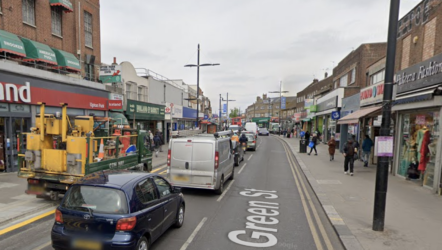The longest medieval cathedral in the world, Winchester, is 170 metres (558ft) from end to end. The new stations on the Elizabeth line are 240 metres (788ft) or more long, and sometimes nine or 10 storeys underground. And these are only the most visible manifestations of the vast volumes hollowed out of the London soil to achieve an underground railway bigger and faster than any before, of what was at one point the largest transport engineering project in Europe, decades and billions of pounds in the making, a system more technologically complex, says its chief executive, than any outside China.
Sometime soon – those in charge won’t be more specific than “the first half of 2022” – 10 of these stations on the central section of the line will open. Another, Bond Street, will open a little later. To visit them now and ride the distance-shrinking trains, as I did over the past three weeks, is eerie and impressive. It is an alternate universe of London transport, hitherto unseen. Everything – trains, signs, lights, doors, advertisements – is up and running. It’s just that there aren’t yet any passengers.
It is as if you took a traditional underground line and pressed a three-dimensional enlarge button. The trains will carry up to 1,500 passengers, which is nearly twice as many as, for example, the Piccadilly line, at rates (eventually) of up to 24 trains per hour. At Liverpool Street the platforms extend enough to reach what, in the old money of not-supersized tubes, is a wholly different station, Moorgate.
To return to the Central line after the Elizabeth line feels like Alice in Wonderland after she ate her enlarging cake
When the line is fully joined up and operational – in 2023, we’re told – its 73 miles (118km) of track, 26 miles (42km) of it in new tunnels, will run uninterrupted east-west, across the capital and beyond. It will go from Reading in Berkshire to Shenfield in Essex and Abbey Wood in south-east London. To return to the cramped old Central line after a visit to the Elizabeth line is to feel like Alice in Wonderland after she ate her enlarging cake.
This megalopolis of engineering currently lies there, pristine, unspotted by gum or pigeon, with its 319-tonne trains gliding quietly through every few minutes, empty, so that those operating the system can familiarise themselves with the choreography of all that heavy metal. Electronic indicator boards announce their coming with white digits, a notch classier than the orange ones on the old tube. Double layers of doors, there being a glass wall between platform and train, swish open and shut.
Farringdon station. Photograph: John Zammit/Crossrail Ltd
The coming of the Elizabeth line, formerly known as Crossrail, has long been a background hum. Its opening was formerly promised for 2018, then 2019, then some time between October 2020 and March 2021. But few appreciate the scale of its potential impact. London’s underground railway network, which has been growing in fits and starts since the 1860s, is about to expand by 10%. The line will in effect make the city bigger, putting an additional 1.5 million people within 45 minutes of central London. It will run through some of the poshest and poorest places, Bond Street in the West End and Custom House, Newham, in the east. It will take half an hour to get from the centre of the capital to Heathrow.
The line sprinkles real estate fairy dust everywhere it goes. Woolwich, the military and ex-industrial district of south-east London, whose connections formerly consisted of buses, sluggish trains and a quaint but cumbersome ferry across the Thames, now finds itself 15 minutes from the City of London. Here sprout the towers and blocks of a 5,000-home development by the Berkeley Group. Through the centre of the city, high-specification office buildings and apartment blocks are blossoming, in places fertilised by the underground engineering.
Enthusiasm for the line unites the Green party’s London assembly member and former leader Siân Berry with the prime minister, Boris Johnson. “It’s genuinely a really, really good project,” she says. “It’s game-changing for London.” Johnson, as mayor of London, called it “a huge success for the UK economy” and a “transformative new railway”. Lord Adonis, the former Labour transport secretary, calls it “a huge boost to transport capacity in London, a huge extension of the effective commuting zone into central London”.
The dig uncovered pieces of a woolly mammoth’s jawbone, flint tools, Roman coins, Tudor shoes and numerous skeletons
All of which raises questions. The spirit of the project is that of an era of London boosterism, when it seemed that this “world city” could only become bigger, richer and more dazzling, and that this direction of travel would without question be magnificent and beneficial to the whole country, an attitude that took a severe knock with Brexit and has received more blows since. The pandemic reduced the attractions of drawing millions into densely populated city centres. If working from home, at least some of the time, is here to stay, a giant people-moving machine might become less essential. Transport for London (TfL) faces a post-Covid-19 funding crisis, inauspicious for the opening of such an ambitious work. The effects of the Ukrainian conflict and of sanctions on Russia, economic and otherwise, remain to be seen.
It’s worth asking whether giant projects such as the Elizabeth line are the way of the future. It has cost £18.25bn, and it is 33 years since it was proposed in its current form in something called the Central London Railway Study. It can take a generation, in other words, to make something such as this happen. Since we are in a climate emergency, whatever environmental benefits may come from further such splurges on public transport – which incur upfront carbon and energy costs in their construction – may now come too late. Some gurus of mobility argue that driverless electric cars, by using road space efficiently and removing the environmental problems of petrol and diesel, will eventually push urban railways towards obsolescence.
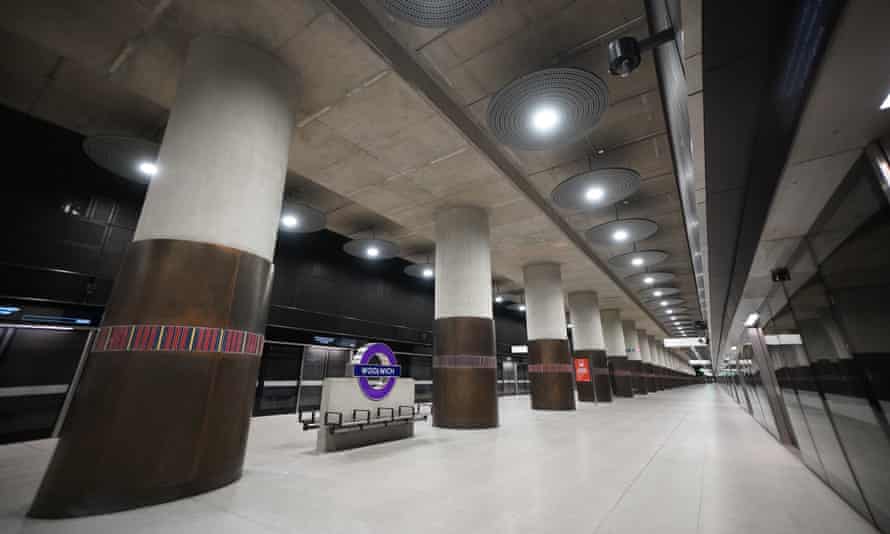 Woolwich’s Elizabeth line station ‘with strips of regimental colour on its bronze-clad columns’. Photograph: © Crossrail Ltd
Woolwich’s Elizabeth line station ‘with strips of regimental colour on its bronze-clad columns’. Photograph: © Crossrail Ltd
And, given that the government has expressed its belief in levelling up other parts of the country, especially in the Midlands and north, huge investment in London’s already extensive transport infrastructure may seem less compelling now than in the past. “I’m sure it’s a splendid piece of technology,” says John Whitelegg, visiting professor at Liverpool John Moores University and an expert in sustainable transport, “but the government told Liverpool it couldn’t have a tram system. How dare we spend £18bn on Crossrail.”
The essential characteristics of the Crossrail concept are that it is a big, fast train that goes from one side of the capital to the other – a heavy railway placed underground. Its origins go back at least to the 1940s (though some trace it to an idea mooted in the 19th century), when it was proposed as part of the postwar reconstruction of London. The name Crossrail came out of a 1974 study that estimated its cost at £300m. The 1989 Central London Rail Study developed the concept, and further work was done in the 1990s and 2000s.
Still, though, central government balked at paying for it. The financial crisis of 2008 seemed to put the project in jeopardy – how could such expenditure be justified when the government was running out of money? – but an act of parliament was passed and both main parties committed to building it. Contractors were appointed, preliminary works started, land acquired, obstacles – which included the venerable London Astoria music venue near Tottenham Court Road – demolished.
Crossrail route mapQuick Guide
Six of the Elizabeth line’s star stations, by Rowan Moore
Show
Paddington
The station at Paddington, designed by Weston Williamson, descends in a deep chasm from the former taxi rank alongside Isambard Kingdom Brunel’s famous Victorian terminus. Sturdy columns and large disc-shaped light fittings give a sense of substance and scale. The 120-metre glass canopy above is printed with Cloud Index, a changing image of the sky by the American artist Spencer Finch, which is part of the line’s extensive programme of public art.
Bond Street
Like most of the Elizabeth line’s central stations, Bond Street comes with significant new development above ground, including a large new commercial building in Hanover Square. Colonnades around the entrances have been designed by the architects John McAslan + Partners to give “a great sense of openness and civic presence”. It has been called the line’s “problem station”, with an increase in budget from £111m to £660m, and its opening will be delayed.
Tottenham Court Road
The new station exits at one end at the foot of Centre Point, the famous and now-listed 1960s tower. At the other it emerges into the heart of Soho. The architects HawkinsBrown has given them “daytime” and “night‑time” characters, one bright and airy, the other finished in dark terrazzo. At platform level there is a network of Grimshaw-designed tunnels and passages, luminous and uncluttered.
Liverpool Street
The length of the Elizabeth line platforms means that those at Liverpool Street reach to the next station on the old underground system, Moorgate. A long subterranean avenue runs from one to the other, with the curving concrete-clad vaults that Grimshaw Architects has designed for several stations. The entrances and exits, by the architects WilkinsonEyre, are animated by shallow fan patterns in concrete and steel.
Whitechapel
Formerly a cramped and convoluted tube station, Whitechapel is now bridged by an ample new concourse, and oversailed by a swooping roof, which its architects BDP says will help connect communities on either side of the tracks. Like all new Elizabeth line stations, it is wheelchair-accessible to platform level. Some of the details are clunky, but the new station gives new grandeur and dignity to the daily commute.
Woolwich
The area famous for its old armaments factories, poorly connected until now, is being transformed by the Elizabeth line. A development of 5,000 homes is going up around it, by property company Berkeley Homes, which also helped to build the station and provided the land for it. The architects Weston Williamson has given it a military theme, with strips of regimental colour on its bronze-clad columns
Thank you for your feedback.
In 2012 four pairs of 1,000-tonne, £10m tunnel boring machines, giant mechanical moles with the canteen and toilet facilities of a small ship, started chewing through the subterranean mud. Huge caverns were formed, and 7m tonnes of earth expelled, three-quarters of it to form a new nature reserve at Wallasea Island in Essex. Three-tonne sections of concrete, to make tunnels meant to last at least 120 years, were installed with heft and precision. The route had to be plotted with care, snaking around to avoid the foundations of skyscrapers, sewers and other underground tunnels.
The operation had byproducts: it became the largest archaeological dig in Britain, uncovering pieces of a woolly mammoth’s jawbone, flint tools, Roman coins, Tudor shoes, Victorian pickle jars and numerous skeletons, many of them those of plague victims. Community centres were redecorated, a city farm spruced up, a literary festival supported, as part of a programme to support the neighbourhoods where the works took place. Public art, including the mile-plus-long “Newham wall” on which the locally raised Sonia Boyce controversially mentioned the murder rate in the area of north Woolwich, was extensively commissioned.
It is a rule of construction that time and money, paramount before a project is completed, are rapidly forgotten thereafter
The last time I wrote about Crossrail, in 2013, which involved exploring deep vaults of concrete and clay, I heard confident-going-on-hubristic claims about its delivery within time and its then budget of £14.8bn. “Do not underestimate UK plc’s ability to deliver such projects,” the then Crossrail chief executive Andrew Wolstenholme told me; Britain “has developed a skill set and a reputation second to none”. It didn’t quite work out like that. “We got ourselves into a pickle,” says Mark Wild, who became chief executive in 2018, with the task of sorting things out. The civil engineering – the heavy stuff – had gone well, “a brilliant, brilliant job”, completed in about 2015. But “we got into a muddle” with all the systems that go into it, “the immense density of digitisation”, the “world’s most complex signalling”.
It is, though, a common rule of construction that time and money, which seem paramount before a project is completed, are rapidly forgotten thereafter. Few who swipe their cards on the ticket barriers will be much bothered about the difference between nearly £15bn and £18bn-plus, and the four-year delay will be forgotten. What they will see are what Andy Byford, who has been London’s transport commissioner since May 2020, calls “aesthetically stunning” stations. “I think people will be blown away when they see the scale and the very pleasant environments.”
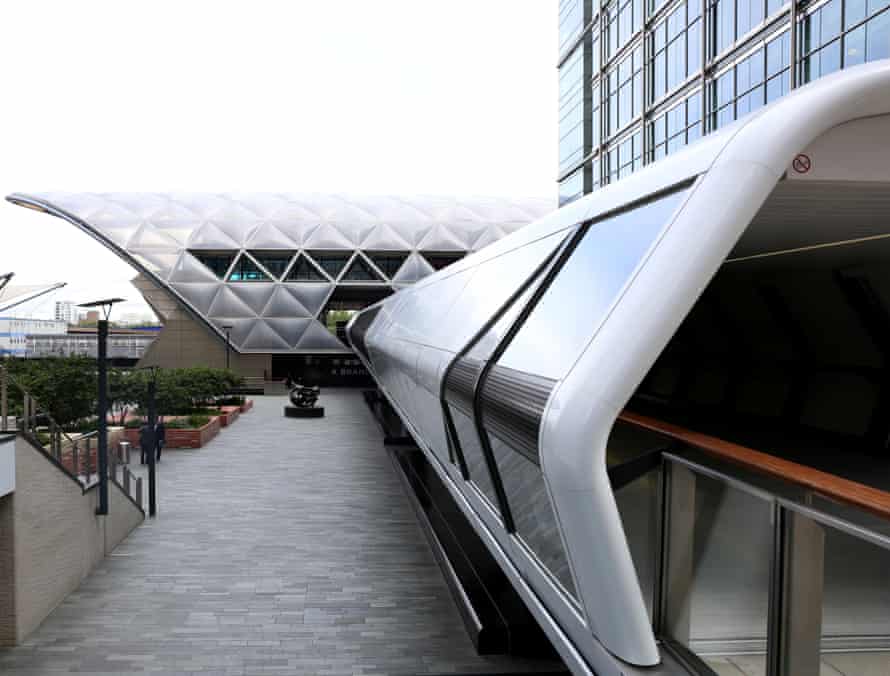 Canary Wharf Elizabeth line station. Photograph: Uyen Luu/Crossrail Ltd
Canary Wharf Elizabeth line station. Photograph: Uyen Luu/Crossrail Ltd
There is some history to the design of underground train stations. There are the palatial caverns of Moscow, rococo and neo-classical, ballroom-like, encrusted with sculpture and painting. There are the more restrained structures – such as the chaste rotunda and semi-rotunda that respectively stand over Arnos Grove in north London and Chiswick Park in the west – built under the leadership of Frank Pick, who was chief executive of London Transport in its glory years in the 1930s. These are elegant and considered, with touches of quality in bronze or stone, part of a unified vision of a well-designed public service that also included signs, typefaces, advertising and the famous London underground map.
The Elizabeth line architecture is more in the Frank Pick tradition than Moscow’s. “We’re not being extravagant,” Byford is at pains to say. “We don’t have chandeliers.” Instead you get what they call “line-wide design”, by the engineer Atkins, Grimshaw Architects, the designer Maynard and the lighting designer GIA Equation, whereby seats and fire equipment and all the other paraphernalia of stations are marshalled into a consistent, robust and uncluttered design. Speakers, signs and lights are organised into free-standing “totems”. In the stations that are tunnelled (as opposed to being placed in boxes), the same systems of curving concrete panels are employed throughout. Full-scale mock-ups were built to make sure it would all fit together well.
The idea is to be calm and clear, a world away from the muck and rattle of the old tube
The effect is luminous. Visual bric-a-brac is kept under control, and advertising is restricted to those places where it will be most noticed; for example, on video screens next to the doors to the trains, which leaves expanses of pale walls, softly uplit, scored by the joints in the concrete and perforated above head height for acoustic reasons. Where one passage joins another the corners are rounded, which will ease the flow of people. It also makes for pleasing shapes where one curve meets another, the concrete folding like handkerchiefs in the wind, of a complexity that would be impossible without digital design and manufacturing. These large pieces of people-plumbing feel smooth and homogeneous, as if formed out of a single substance.
The idea is to be calm and clear, a world away from the muck and rattle of the old tube, and to help people find their way around. Given the length of the platforms, a wrong turning by a passenger could result in a long, wasted walk. Then, in the sections that connect to the streets above, the designs become more individual and bespoke, in response to the particularities of the neighbourhood. Ten different architectural practices have designed the 11 stations of the central section, making them a showcase for the more engineering-minded end of British architecture.
At Tottenham Court Road, HawkinsBrown Architects has given different characters to the entrances at the opposite ends of the station: a “nocturnal” connection in dark terrazzo to the fleshpots of Soho, a light and airy “daytime” one at the other end. Weston Williamson, the architect for Woolwich, has designed a disciplined file of sturdy columns, bronze-clad at their base, decorated with strips in the colours of the regiments associated with the area’s historic military facilities.
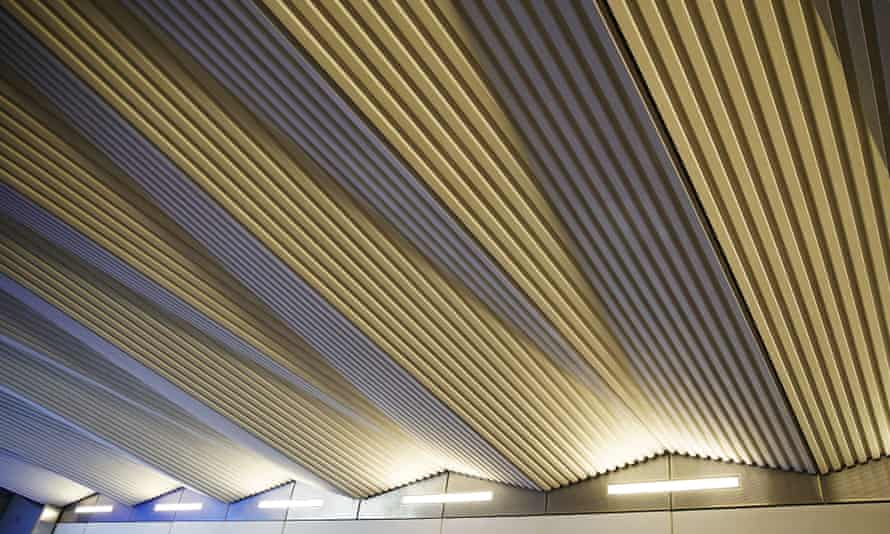 The ceiling at Liverpool Street station. Photograph: Chris Bevan Lee/Crossrail Ltd
The ceiling at Liverpool Street station. Photograph: Chris Bevan Lee/Crossrail Ltd
The project’s architects like to exploit the drama given to them by the engineering, such as deep plunges down from pavement level at Paddington and Tottenham Court Road. WilkinsonEyre, at Liverpool Street, has conceived a concrete vault that folds like shallow origami, whose triangular patterns are echoed in aluminium panels on the escalator walls. The firm has also made a thing of the crisscross trusses of an office block above the station’s western entrance, which carry the new building over the big open spaces below.
These stations feel more orderly and managed than those of the Jubilee line extension, completed in 1999, at the time a bold and famous adventure in architectural commissioning. The late Will Alsop, who designed the moodily dramatic dark blue North Greenwich station for the Jubilee line, initially worked on Paddington for the Elizabeth line, but the job eventually went to Weston Williamson, also a veteran of the Jubilee line, but more level-headed.
Sometimes, in the new stations, calm and consistent translates as bland. A few details, as a result of the ways in which large buildings are now procured and built, clunk. The stations tend to get less convincing where they engage with their messy surroundings at street level, more so when they get close to trains and engineering. But the dominant impressions are of handsomeness and amplitude, expressed in big circular light fittings at Paddington or the high-ceilinged rebuild of the formerly crabby layout of Whitechapel.
This composite work of architecture is one to which some people have given the best part of their careers. Julian Robinson, the project’s head of architecture, has been working on it (with breaks to work on the Jubilee line and the London 2012 Olympics) since 1992. Roger Hawkins of HawkinsBrown tells how his wife gave birth to their son the night after he was interviewed for the Tottenham Court Road commission. The lad will turn 30 next week. One of the project’s most remarkable achievements is its unity and cohesion, given the multiplicity of consultants, contractors, suppliers and commissioning organisations. This is not the work of a single public body but of multiple partnerships with the private sector. The stations at Woolwich and Canary Wharf, for example, were built by the private developers that own the respective sites.
So this queen of tubes, branded in royal purple, will hopefully open in time for its namesake’s platinum jubilee. The purpose of the architecture is not just vanity, but also to raise the desirability and prestige of public transport, so as encourage people out of cars. The stations will also give a lift to their neighbourhoods – not much needed in Bond Street, perhaps, but helpful in some of the less favoured places touched by the line.
The line will, says Byford, be “the ultimate symbol of London’s re-emergence from Covid, a massive morale boost”. Berry says: “A car-free recovery is exactly what we need. It will make a difference to many people’s perceptions.” Wild says: “The asset that we have built is one of this century’s great engineering achievements.”
Byford acknowledges that the pandemic “has driven coach and horses” through TfL’s plans, and is worried about short-term underfunding, which could lead to a “downward spiral” of managed decline, but he says that the business case for the Elizabeth line “is still compelling”. Pre-Covid, the prediction for passenger numbers in 2026 was 250 million. “Now it’s 130-170 million but could be 200 million.”
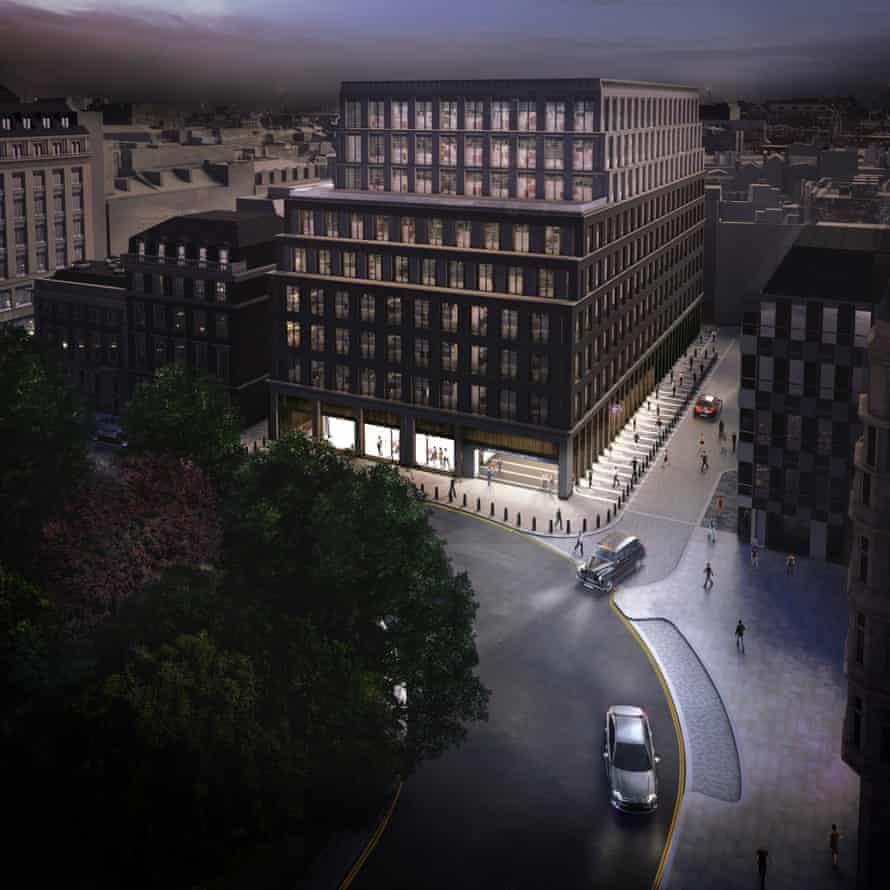 An architect’s image of Bond Street’s significant above-ground development. Described as the project’s ‘problem station’, the Bond Street Elizabeth line station will be delayed. Photograph: Crossrail
An architect’s image of Bond Street’s significant above-ground development. Described as the project’s ‘problem station’, the Bond Street Elizabeth line station will be delayed. Photograph: Crossrail
Tony Travers, visiting professor at the London School of Economics’s department of government, believes that London will bounce back: “If plague and cholera and the second world war and deindustrialisation didn’t do for London, you have to assume that it will survive.” In which case the Elizabeth line, “whose case was based on the ever-growing density of London”, will be justified.
On the question of levelling up, the line’s fans have many answers. One is the amount of work that its construction created nationwide: 75,000 people have worked on Crossrail, says Wild, “the majority of them all over the country”. He cites trains from Derby, vitreous enamel signs from the Isle of Wight, fire doors from Bolton, fibre communications from Ashby de la Zouch.
Travers argues that failure to invest in London’s transport would be a case of levelling down, not up. In which case global companies such as Google wouldn’t look to locate in other British cities, but international rivals such as Amsterdam. He points out that most of the funding of the Elizabeth line comes not from central government but from business rates, levies on development and other sources within the capital. Also, that London has large areas of deprivation that are as much in need of levelling up as anywhere else.
None of which satisfies Whitelegg. Transport spending per head, he says, citing a 2018 report, is £944 per head per year in London, compared with £314 in the West Midlands. It would be much better to invest in local integrated networks of buses and cycling of a kind that he has worked on in Germany and elsewhere that benefit “more people more immediately at lower cost”. He argues that there is a remarkable lack of evidence for the Elizabeth line’s alleged environmental benefits.
 Curving concrete panels and free-standing signage ‘totems’ at Tottenham Court Road. Photograph: Rowan Moore
Curving concrete panels and free-standing signage ‘totems’ at Tottenham Court Road. Photograph: Rowan Moore
What the Midlands and north have been offered instead is the HS2 high-speed rail link, costing about £100bn, of uncertain delivery date and whose scale makes the Elizabeth line look like a Tri-ang Hornby toy. Meanwhile, London’s Crossrail 2, a north-south version of the same idea, has been put on hold.
Travers points out that infrastructure projects are not conceived in conditions of calm objectivity, but reflect such things as the lobbying power of particular cities – in the case of the Elizabeth line, the City of London and an organisation called London First did much to push the project through. The mighty construction industry that builds such projects also has political momentum. What gets built is not theoretically the best solution, but the most likely to be achieved in the circumstances. It is never really possible to know, once it’s built, how a given project would compare with imaginary alternatives.
So maybe there is a better, smarter £18bn theoretical transport project than the one that is about to open, that will never be seen. There is good reason to believe that there are better, smarter alternatives to HS2. But, for now, the natural reaction to the Elizabeth line is to be deeply impressed.
https://www.theguardian.com/uk-news/2022/mar/13/elizabeth-line-crossrail-opening-london



